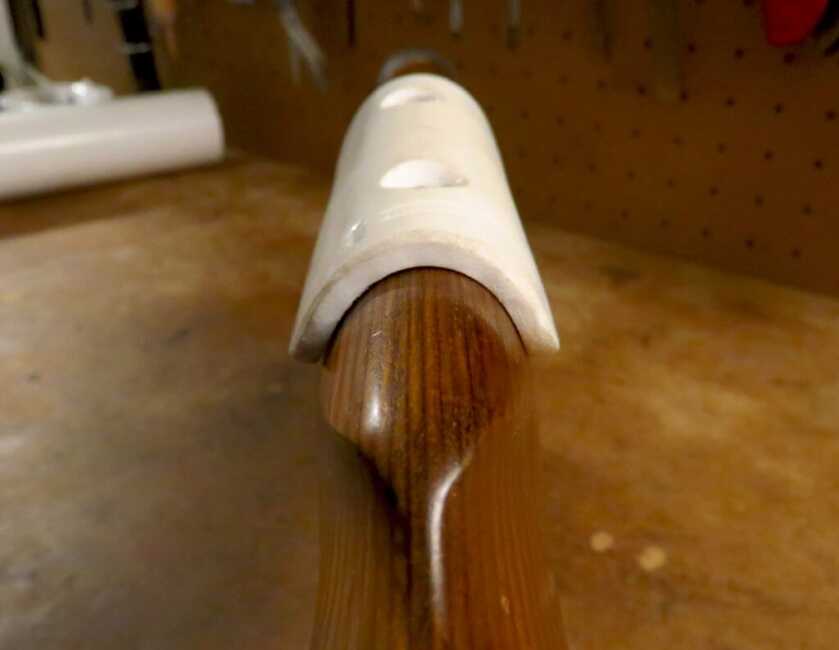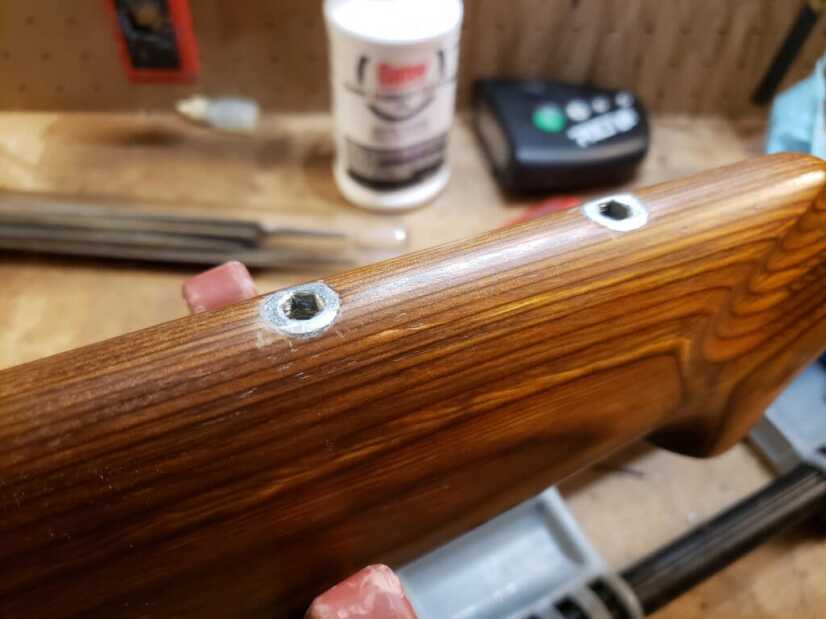The term “bubbagunsmithing” can carry a lot of negative connotations that often elicit images of destroyed firearms by people that shouldn’t be allowed to have hand tools. However, I’d like to elevate the idea of bubbagunsmithing to a person’s skillful use of what they have available in order to improve a firearm’s capabilities. In light of this lofty goal, I decided to try my hand at adding a cheek riser to the factory stock of my Remington 783 Varmint. Traditional solutions may have had me resort to duct taping shop rags to the stock, but I wanted an honest-to-goodness cheek rest that looks like it belongs. I could’ve just ordered something off the internet but most of the stuff I used came from the hardware store down the street.
Tools and Materials

The material list is pretty simple as it turns out:
- 2″ schedule 40 PVC pipe, 2 ft. long
- Two ¼-20 threaded inserts with a flange
- Two ¼-20 X 2” flat head bolts
- Two-pack nylon spacers
- Rubber washers
- 5-minute epoxy
The above items will net a functional cheek rest, but I wanted some comfort too, so I bought a $1 sheet of self-adhesive foam from the hobby store.
The tool list is also just as simple:
1. A hack saw.
2. Drill and drill bits
3. Sanding block and sandpaper
4. Heat gun
5. Cord, tubing, zip ties, or bungees
The First Cuts
The first step in this project was to cut off a 5” long section of pipe and cut that piece in half lengthwise. The cuts came out a little uneven but that turned out to be fine, enough material was going to get removed from the sides that it would even up. I marked a centerline down one of the halves and drilled the holes for the bolts that would go down into the stock. The distance between the holes is arbitrary, I positioned them about 3” apart center to center. I marked a similar centerline down the comb of the stock and overlaid the PVC half on top of that, positioning it in the right place for a good cheek weld.

Next, I took the heat gun and heated the PVC to become flexible enough for me to form it to the shape of the stock. I recommend some gloves for this step, that PVC gets quite hot in the process. I secured the piece to the stock with zip ties so that it would hold its shape as it cooled. Electrical tape, surgical tubing, or cordage would probably work just as well.

Anchorage
After the cheek piece had been formed to the stock I set it aside and went to work on the stock itself, locating and drilling the holes for the threaded inserts. There was no particular reason I went with a ¼-20 thread pitch other than it’s commonly available and should provide enough support. The threaded inserts were the flanged screw in type that I glued in with a quick drying clear epoxy.

I used nylon spacers to raise the cheek piece to the proper height and the flange of the inserts gave it solid bearing.

Finishing The Cheekpiece
I made some rough cuts with the hacksaw to give the cheek piece its final form and then used sandpaper to even them out to look more symmetrical. It’s really important to wear a good dust mask and eye protection to ward off the PVC dust, you definitely don’t want to breathe that stuff in or get it in your eyes.

A black sharpie on the edges of the cheek piece masked the white edges and helped it blend in with the stock once installed. The spacers that I used were ½” long and small rubber washers from the plumbing department helped me fine-tune the height.
In Use
When I took the rifle back to the range to zero, the height of the cheek riser was just right so that I had a nice full field of view when I got in position. The foam covering on the cheek piece was a great touch and settling into the gun was very comfortable with no chance of my face slipping around. I can remove the bolt with the cheek piece installed as it is, however, cleaning will require me to remove it so that there’s enough room for the cleaning rod.
It’s pretty cool what a person can MacGyver into existence with a little ingenuity and a good local hardware store.

***Buy and Sell on GunsAmerica! All Local Sales are FREE!***

I have non permanent cheek risers on all of my rifles. I use double sided carpet tape, foam pipe insulation of various diameters, and an old traditional leather arm guard, which is the one piece that moves from gun to gun as needed. A note; make sure your riser allows you to remove the bolt.
Cut the pipe insulation in half. Cut to length. Lay down strips of double sided carpet tape between layers of pipe insulation. Build to height and cover with the old arm guard or whatever you want to use as the layer where your check will lay. My old arm guard is wide enough that it covers a majority of the sides of the stock.
All held in place using the 4 antler buttons on one side with elastic cord running under the bottom the stock, thru the arm guard, and held by quick release spring retainers. Once you have the basic structure in place all you do is move the top cover from gun to gun. Easy and very cost effective. Tanned or smooth leather works great for the top layer. Carpet tape works really well.
I am almost fanatical about mounting the scope as low as possible and then adding a stock riser pad (if needed) to give a perfect stock weld to align my eye with the center of the scope. You will find, however, that perfect alignment varies with your shooting position (standing to prone especially). I really like the article. I was wondering if a Moleskin or neoprene pad would work in place of the foam. Got me thinking.
Quit cryin’ about trashing the stock. #1 It’s his stock….. #2 It’s not a piece of fine Circassian walnut. You ain’t got a dog in this hunt, son.
Congrats. You trashed a stock.
I guess thats pretty cool ..